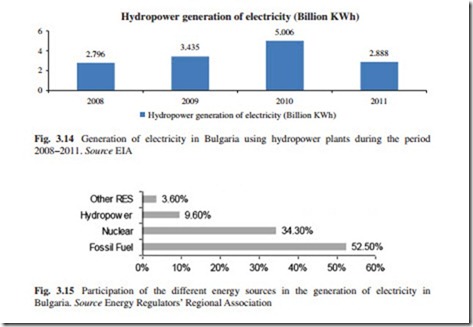Bulgaria
Despite having limited reserves of coal, oil, and gas, the country has a well-developed energy sector. According to Todorova (2011), Bulgaria is a major exporter of electricity to Southeast Europe, generated mainly by thermal, nuclear, and hydro- power plants. Bulgaria also has the capacity to become a leading generator of power from renewable energy sources, especially wind. This will require significant investment and increased efforts to build public support. Currently, the public is in favor of nuclear power, which is seen as the reliable, lower cost option for households. The Bulgarian government needs to balance its desire to please the electorate with its responsibility to comply with EU accession requirements (by retiring its old nuclear power plants) and to meet EU renewable energy targets.15 Bulgaria also imports over 70 % of the fuel required for power generation and is therefore keen to develop a power sector based more on local resources.
Hydropower Installed Capacity
In 2012, the total installed hydropower capacity in Bulgaria was 2,251 MWe. This capacity represents 19.85 % of the total energy power capacity installed in the country. The hydropower capacity installed in Bulgaria represents 59.11 % of the total renewables capacity installed in the country in 2012. Bulgaria occupies the place 46 in the world according to their hydropower capacity installed (0.23 % of the world installed capacity). Within the EU, Bulgaria occupies the place number 4 according to the hydropower capacity installed (6.48 % of the European hydro- power capacity installed).
In the past 10 years, the hydropower capacity growth at a rate of 1.27 % per annual. During this period, the capacity installed growth in 7 of the 10 years considered.
Despite the numerous ambitious energy projects now being initiated, there are still many obstacles to overcome. One of these obstacles is that Bulgaria relies heavily on foreign investment for the development of the energy sector (both green and brown). According to the Center for the Study of Democracy, implementation of large-scale energy infrastructure projects is frequently hampered by:
• The lack of a sound energy strategy with clear priorities;
• Apparent conflicts of interest at the highest political level, arousing suspicion of corruption;
• Poor management of state enterprises;
• Numerous monopolistic abuses at consumers’ expense and the absence of adequate independent oversight;
• Politically motivated privatization of assets and lack of regulation of capital
entering the energy sector (Todorova 2011).
Hydropower Electricity Generation
One of the key objectives of the National Energy Strategy to 2020 is the privatization and rehabilitation of existing hydropower plants and construction of new ones, mainly on the Danube River. The government anticipates particular interest on the part of investors in small-scale and micro-hydropower projects.
Bulgaria has a relatively small hydropower potential, and therefore, the importance of hydropower generation is limited and most of them are located in the Southern and Southwestern mountainous parts of the country. Most of these power plants are large-scale reservoir type.
Run-of-the-river small hydropower plants exist in Bulgaria, and before 2011, additional investments in the sector are considered unattractive due to the very low feed-in tariff (FiT) in force since the approval of the Renewable Energy Act. The new FiT approved in 2011 increased the interest for small hydropower plants.16
The evolution of the generation of electricity by hydropower plants in Bulgaria during the period 2008–2011 is shown in Fig. 3.14.
According to Fig. 3.14, the generation of electricity using hydropower plants in Bulgaria during the period 2008–2010 increased 79 %. However, in the period 2010–2011, the generation of electricity using this type of energy source decreased significantly (42.4 %).
The participation of hydropower in the generation of electricity in Bulgaria rep- resents 9.6 % of the total electricity generated in the country. The participation of all renewables in the generation of electricity in the country is 13.2 %. The aim is to have 16 % of the total electricity consumed in the country in 2020 using different renewable energy sources (Liu et al. 2013).
According to Fig. 3.15, hydropower generated 9.6 % of the total electricity produced in the country well below the electricity generated by nuclear power plants and fossil fuel power plants. It is expected that the role of the hydropower plants
in the generation of electricity in the country will continue to be relatively low in comparison with other energy sources during the coming years.
